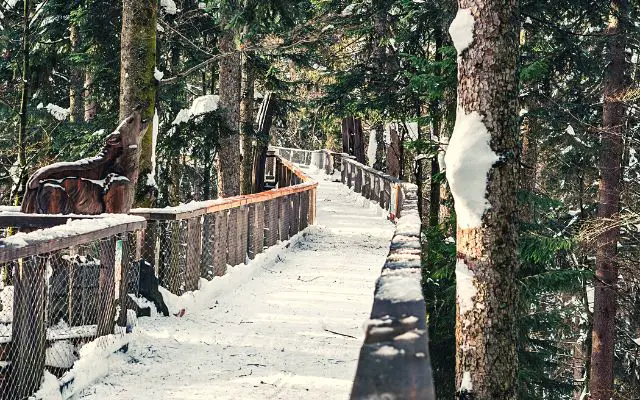The Bavarian Forest National Park (German: Bayerischer Wald) is the oldest, largest, and one of Germany’s most beautiful national parks.
Established in 1970, it stretches south from Bayerisch Eisenstein right along the Czech border to the village of Mauth some 40 km to the south-east.
The National Park’s allure comes from the rich wilderness that has been allowed to flourish with little interaction from humans.
The park protects the greatest undeveloped stretch of land between the Atlantic and the Urals where the landscape has been untouched and permitted to gradually revert back to an almost perfect natural state.
Popular in both Summer and Winter the Bavarian Forest National Park is an idyllic destination that’s adored by Bavarians and tourists alike.
We hope you’ll get the best out of this concise Guide to the Bavarian Forest National Park and we sincerely hope you enjoy the read.
Attractions Of The Bavarian Forest National Park
Among the park’s many attractions are a stunning landscape, hiking and biking routes, majestic peaks, mirror lakes, an exciting tree-top walk, and oh so much more.
While the forest is a great place to explore in the summer, it transforms into a mystical region in the winter which sees the forest floor covered with a thick white carpet, lakes frozen solid, and tree branches covered in snow.
There are numerous people who come for the purpose of engaging specifically in winter sports here in the Bavarian Forest National Park, including cross-country skiing, hiking, and snowshoeing.
No matter what the season, tourists must be mindful to take great care, and not disrupt the wildlife or the forest’s tranquility, as the forest service is notoriously strict about this.
Here are what we believe to be the BEST attractions of the Bavarian Forest National Park in no particular order.
Tierfreigelände
The Tierfreigelände is a large animal enclosure with no visible fences and is structured to look as much like the animals’ natural habitat as possible.
European bison, wolves, wild boars, lynxes, and bears are just some of the many animal species you can observe in their natural habitats. The barrier-free route around the Tierfreigelände is packed with fun for the whole family.
In the woods themselves, it’s highly likely that you’ll be able to spot birds, mice/voles & ‘red’ squirrels and the whole experience is delightful even with the occasional lack of appearance by the star attractions such as the Lynx and the elusive Beaver.
There are specialist 2.5 hour guided walks of the Tierfreigelände which can be far more productive than walking alone.
The tours are guided by volunteers, who are really very knowledgeable about the forest and the animals. There is much background information given about the Bavarian Forest National Park and the guides have secret inside information which means they know almost exactly where most of the animals like to hide.
Animal activity is certainly heightened in the evening and at night so if you can swing it, visit late in the day to give yourself the best opportunity to spot the most wildlife.
Rachelsee
Rachelsee, an astonishingly beautiful lake, is nestled at an elevation of 1,071 feet in the heart of the forest.
This mirror-like lake is full of dark stories and myths from the area and is allegedly named after the Devil’s grandmother, Rachel.
Overseen by the highest peak in the National Park – the Großer Rachel, and guarded by the wonderfully woody and interesting Rachelkapelle (Rachel’s Chapel), the lake is a veritable “diamond in the rough” and can only be reached on foot so this is a wonderful place for hiking.
As one of only three Karseen lakes within the Bavarian Forest National Park, the Rachelsee was formed and excavated by glacial movements during the last ice age.
Don’t forget to ring the bell inside the Rachelkapelle when visiting, you’ll be astounded at just how far the sound carries in this gorgeous spot.
Baumwipfelpfad Bayerischer Wald – Bavarian Forest Treetop Walk
The Bavarian Forest National Park Tree-Top Walk (Baumwipfelpfad) provides an up-close interaction with nature and an exciting adventure for the whole family.
Visitors can walk the 1,300 meters along a barrier-free wooden boardwalk to the base of the dome-shaped observation platform, which offers breathtaking views of the surrounding forest.
Exciting side attractions can also be found along the way with displays and interactive physical challenges along the route, but the best part is saved for last.
Experience untouched nature from a unique perspective by climbing to the observation deck, which is 44 meters above ground. Here you can take in truly stunning views of the surrounding woods and, on clear days, the snow-capped Alps in the distance.
The Baumwipfelpfad restaurant serves delicious snacks and if you have kids they’ll enjoy playing in the wonderfully equipped upstairs indoor playground. Perhaps whilst you’re enjoying a beer and an apple strudel (Apfelstrudel).
Hans-Eisenmann Haus
Just adjacent to the Baumwipfelpfad is the Hans-Eisenmann-Haus Visitor Centre which provides information about all the activities that are available in the Bavarian Forest National Park.
The exhibition “Paths into Nature – A Story of Forests and People” is a permanent display that answers the following questions:
- What does the philosophy “let nature be nature” mean?
- What desires do people associate with the forest?
- How has the protected area evolved since it was founded?
- What kind of species lives within the emerging wilderness?
Contained within is a small, yet interesting museum that fully details the history of the National Park and there is also a reading gallery, a cinema with films about the national park, and a shop for souvenirs.
Kids love it here as there are tricky puzzles to be solved and In the children’s adventure room, kid-friendly natural treasures are just waiting to be discovered.
Getting To The Bavarian Forest National Park
The Bavarian Forest National Park in Germany is easily accessible by road, rail and bus so getting here won’t be a problem.
Also, once there, the local council instigated a smart transport concept some years ago, ensuring visitors will easily be able to reach all the most prominent locations in the National Park by public transport should you not wish to drive yourself.
By Car: A number of major highways feed into the area. Depending on where you’re planning on coming from you could take the A3 (Nürnberg – Linz), the A92 (München – Deggendorf) or the A93 (Hof-Regensburg) to get you in the direction of the National Park. Once you’ve made it into the region the smaller local roads such as the B85 or B11 will take you further and deeper into the forest proper.
By Rail: Plattling station is the major rail hub here in this region. It’s on the ICEs Frankfurt – Vienna line between Regensburg and Passau and on the regional line via Landshut from Munich. There are actually direct regular trains from Munich Hbf to Plattling.
In The Forest: Obviously you can drive yourself about the National Park. It’s well signposted and there is plenty of parking from where you can hike to the various places of interest. The best way to get about however, is with a guest card called GUTi, which covers public transport in and around the national park.
The GUTi guest card is issued free of charge by most accommodation providers and is valid for whatever your length of stay might be in the area. The GUTi card is actually your ticket which allows for unlimited travel in the Bayerwald-Ticket area (except the Bayerwald-Ticket-PLUS area). Your GUTi also acts as a discount card and you’ll receive free or reduced price offers throughout the region.
Here is a detailed map of all the local transport routes in the region.
Location Of the Bavarian Forest National Park on Google Maps
Accommodation Nearby the Bavarian Forest National Park
For those visiting the park and looking for nearby locations to explore or a place to stay, here are a few of the best towns and cities to visit in the area:
Regensburg
Northwest of the park is the city of Regensburg, which is home to more than 150,000 people. The city’s historic center is listed as a World Heritage Site by UNESCO, making it a popular tourist destination in Germany.
The city is also home to the Museum of Bavarian History, which provides an in-depth look at the region’s rich heritage.
Deggendorf
The settlement of Deggendorf can be found due west of the park. There are about 34,000 people living in the town, and the earliest records of humanity in the area date back to 868 CE.
The unique and charming architecture of the town was remarkably unharmed by World War II, making it the perfect location for a trip back in time.
Passau
To the south is Passau, which is a city right on the Austrian border that lies at the intersections of three rivers, the Danube, Inn and Ilz rivers.
Consequently known as the Dreiflüssestadt (Three Rivers City), Passau is guarded by the imposing Veste Oberhaus, a 13th-century hilltop fortress that houses the city’s museum and includes a fantastic observation tower.
The city was originally a Roman colony but is now a University City that sees a quarter of its inhabitants being students at any one time. This means that there is a vibrant art, culture, and cafe scene in the city as well as plenty of accommodation.
Zwiesel
Only a town since the beginning of the 20th century Zwiesel is now one of only a handful of places in Germany and Austria classified as a ‘Luftkurort‘ – a climatic spa resort.
This is a town that experts deem has an air quality and climate that is considered beneficial to health and recovery of various ailments. Municipalities with this classification are permitted to charge a health resort tax for all guests who spend the night there.
Zwiesel is the gateway town of the Bavarian Forest National Park and there are two separate Zwiesel Tourist Offices. One office is to be found in the Town Hall and is open from Monday-Thursday plus Friday mornings. The other smaller office which is located in the Waldmuseum near the church is open daily apart from Tuesdays, so serves the weekend crowds.
Famous for its glass production this former mining town sits on the junction of the Großer and Kleiner Regen rivers and you’ll find dozens of hotels and family-run apartments and pensions in the town making it an ideal place from which to explore the National Park.
Bavarian Forest National Park: Final Thoughts
The wooded mountainous terrain, the numerous lush valleys & the picturesque villages that make for some excellent panoramas are just part of the natural joy that you’ll experience in the area.
There are many traditional and very charming festivals and events in the warmer months throughout the region, making this particular part of Bavaria a “must-see” destination.
The park joins up with the Šumava National Park of the Czech Republic to form a sort of mega forest, and crossing the border here is quite commonplace to explore both areas.
Whilst the Bavarian Forest National Park is a major drawcard some of the towns here are interesting touristic places in their own right, with many well worth a visit.
We love nature here at Absolute Munich and we love getting out and about to enjoy some challenging hikes which is why we’re big fans of visiting the Bavarian Forest National Park.
We hope you’ve enjoyed our guide to the National Park and, if you ended up visiting here, we’d love to hear from you about your trip to the park.
Cheers and thanks for reading.

